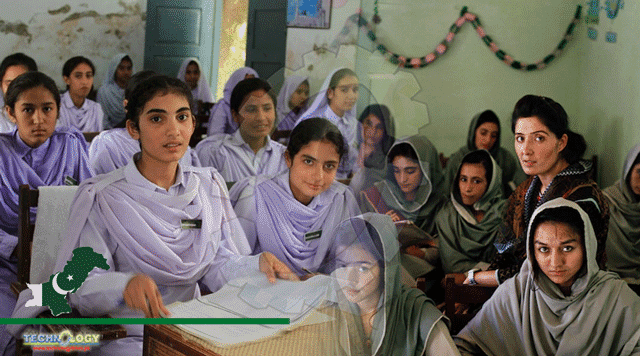While 22 percent of mainstream (Muslim) female aged 18-29 could get education until grades 12 and above, the literacy rate of minority women was lower (11 percent). Four percent of non-Muslim women sought employment and 2.6 percent were employed.

When a Hindu female asked her parents for permission to get education in Lahore, they referred to nearby cities.
“It was a challenge to convince them. I argued and cried for four days. They were afraid of the ongoing forced conversions of Hindu girls in Sindh province,” said Chahat.
“Similar fears lead to early marriages of minority girls. We cannot step outside without family members. It affects our education as well.”
The activist hails from the southern Pakistani city of Shahdadkot in Sindh province where the enrollment of girls in schools has declined while the dropout ratio has risen, according to Alif Ailaan, a pro-education NGO. More than half a million of Hindus are settled in Sindh where several cases of forced conversion and marriages of Hindu girls have been reported.
In Lahore, Chahat was asked about her nationality by her classmates.
“They asked if I own an Indian identity card. Minority women have to struggle more in our patriarchal society. Discussions and group visits to different places of worship can clear the myths,” she said.
Since 2019, Chahat has been promoting peace and interfaith harmony among youth. She was one of the female speakers at a March 9 conference on the “Status of Minority Women and their Rights and Challenges” by the Centre of Social Justice (CSJ) in Lahore.
The speakers discussed the socioeconomic and legal rights of minority women in terms of education, health, forced conversions and gender-based violence. The conference resolution urged the government to gather credible data to assess the socioeconomic status of minority women.
“They lag behind in literacy rates, employability in prestigious professions, equal wages, job security, etc., therefore affirmative action should be brought to make them equal in rights and as beneficiaries of opportunities,” it stated.
“Through legislative and educational measures, women and girls must be ensured that they are free from physical abuse, domestic violence and rape, or being subjected to any medical procedure without informed consent, and deprivation of reproductive autonomy and rights.”
Christians pioneered modern education on the subcontinent. In 1849, two Presbyterian missionaries established the first English-medium school in Lahore. Anglicans and Catholics organized education at primary and secondary level. After the creation of Pakistan in 1947, missionary schools were known for their discipline and quality education.
Several political and government leaders studied at missionary schools and colleges. Prime Minister Imran Khan received his early education at the Cathedral School Hall Road Lahore run by the Church of Pakistan. Former premier Benazir Bhutto, the first woman elected to lead an Islamic state, studied at the Convent of Jesus and Mary in Karachi and Murree.
According to CSJ research published last year, the nationalization of Pakistan’s private schools in 1972 resulted in low literacy levels among the Christian community, weakened church institutions and created fear among them.
As per the latest Catholic Directory, the Church manages more than 500 educational institutes in the country. The Catholic Bishops’ Conference reviewed the progress of church-run schools, along with other commissions, during their annual meeting earlier this month.
“Hate material in syllabus and the upcoming single national curriculum were the major issues raised by the Catholic Board of Education and National Catholic Education Commission,” Bishop Samson Shukardin of Hyderabad told UCA News.
“The literacy rate of Christian females is higher than that of the Hindus. We are trying to enroll more females in our schools. However, a large percentage of Hindu-majority districts in Sindh province have no schools at all.”
Survey findings
In 2017, the Punjab Bureau of Statistics and Punjab Commission on the Status of Women (PCSW) undertook the “Women’s Economic and Social Wellbeing Survey” with women, minority women, women with disability (aged 15-64) and a survey for male perception (aged 15-64). Separate industrial surveys for employers and working women were carried out in eight big cities of the province.
It included an additional purposive sample of 1,645 women with disabilities and 2,488 minority women. As per its key findings, 50 percent of non-Muslim women never attended school, 13 percent studied to primary level, 12 percent to grade 10, and 3 percent to graduation or above.
While 22 percent of mainstream (Muslim) women aged 18-29 could study until grades 12 and above, the literacy rate of minority women was lower (11 percent). Four percent of non-Muslim women sought employment and 2.6 percent were employed.
Fifty one percent were employed in the formal sector while 48 percent were in the non-agriculture sector. In villages, 48 percent were employed while 57 percent were employed in urban areas. Twelve percent of minority women could make their own decision about marriage while only 4.2 percent of Muslim women could do that. None of them sought shelter seeking help against violence.
According to Fauzia Waqar, former chairperson of the PCSW, it was the first time data was gathered on minority women of Punjab.
“There is a need to work on employment of educated non-Muslim women. Their political participation is slightly better. Sadly, the results were never published,” she said.
“Early child-bearing of minority women in Punjab is lower than the mainstream; this is good news. However, most of the young mothers, poor and uneducated, are from minorities. A lower literacy rate of minority women is a matter of concern. Their labor force participation is also lower than the mainstream.”
Originally Published at UCAnews